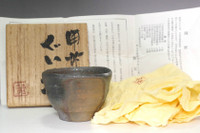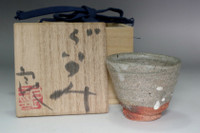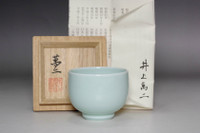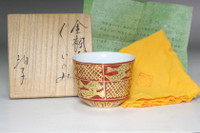 Loading... Please wait...
Loading... Please wait...Currency Displayed in
Categories
Senke School
Senke School
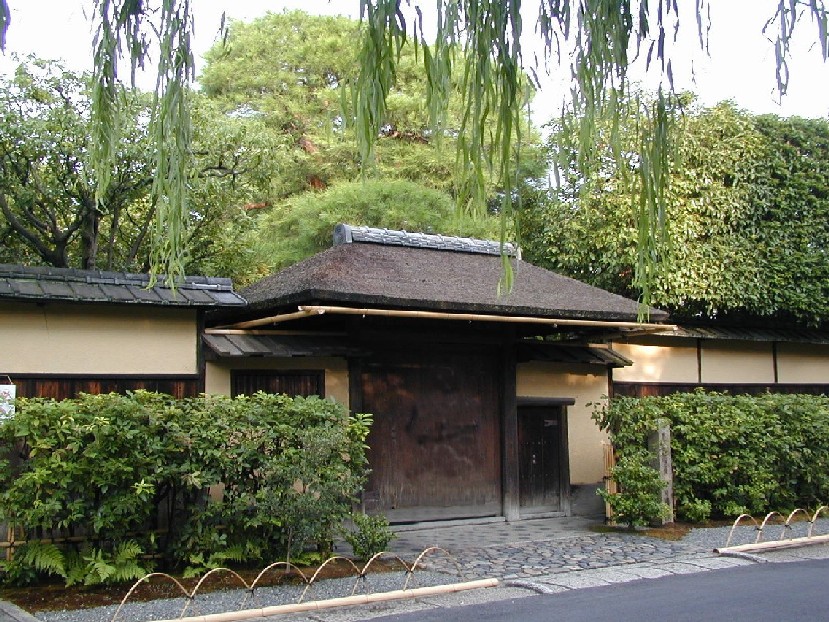
Urasenke is one of the main schools of Japanese tea ceremony and is the largest one among them. The name Urasenke is comes from its house, Konnichian, being located at the back of the main house that was passed down from Sen Rikyu, the Fushin-an of Omotesenke, when seen from the street. (Ura means back side in Japanese) The head house is located in Kamigyo-ku, Kyoto and is near the head house of the Omotesenke. Its tea room, Konnichian is synonymous with the Urasenke name.
After Sen no Rikyu passed away, Sotan, who succeeded Shoan (Rikyu’s stepson) of a collateral family, built his residence in Kyoto. Sotan’s third son, Sosa, inherited the head of the family to start the Omote Senke school, after he served the Kishu Tokugawa family as a tea ceremony master. After that, the second son Soshu started the Mushakoji Senke, and the fourth son Soshitsu started the Ura Senke, which marked the begging of the Three Senke, however, each school considers Rikyu as the founder. Urasenke family inherits Senso the fourth generation’s name, Soshitsu.
Senke the 1st - Rikyu Soeki (Housensai) 1522-1591
About 500 years ago, in what is now Osaka Prefecture's Sakai City, Sen no Rikyu (1522-1591), as the oldest son, became the head of his family at the young age of 19, following the death of his father. Later, he went on to achieve success in commerce and became an influential merchant. He began studying tea out of necessity in his social relationships with his fellow merchants, but would go on to devote himself to it.
Rikyu is famous for his service as the master in charge of tea ceremony for the prominent warriors Oda Nobunaga and Toyotomi Hideyoshi in the turbulent age. The position of tea master included multiple responsibilities, including serving the shogun's family and various daimyo, making the preparations for tea ceremonies, decorating tatami rooms, and evaluating and purchasing artwork.
Nobunaga employed three tea masters including Rikyu, but this may have been in order to make political use of the economic strength and knowledge which they possessed.
Nobunaga's subordinate military commanders also had a taste for drinking tea, and one of them, Hideyoshi, became close with Rikyu. In 1582, after Nobunaga's assassination in the Honno-ji Incident, Hideyoshi's succession and subsequent unification of the country became a significant turning point in Rikyu's life. As Hideyoshi was exceptionally passionate about the tea ceremony, the great success of the practice in the Azuchi-Momoyama Period was due in great part to his influence. One might say that it was due to the backing of such a powerful ruler that Rikyu's style of tea ceremony would go on to become the standard style.
While other styles of tea ceremony employed pottery and utensils imported from China (karamono), and took place in drawing rooms which valued strict formality, Rikyu did not partake in the buying and collecting of these special products. Even after rising to a unique position as Hideyoshi's tea master, he continued to adhere to wabi-cha, a style which requires the spirit of a tranquil heart, and refined it, transforming it into the mainstream style of tea ceremony.
Because Hideyoshi used tea politically, he held tea ceremonies quite frequently. One of the reasons, among others, that he favored tea ceremonies was that they facilitated confidential meetings, and allowed him to invite guests into private, close quarters, encouraging them to develop feelings of intimacy by making and treating them to tea.
As one of his close associates through his employment as tea master, Rikyu's relationship with Hideyoshi became one of intimate friendship. Of the tea ceremonies that Hideyoshi held, the most famous was that held in Kyoto's Kitano Tenmangu Shrine in 1587, the Great Tea Ceremony of Kitano (Kitano Daisanoe). It is said that while over 300 seats divided the shrine's compound, because anyone was allowed to participate, over 1000 people attended. It was Rikyu who managed this grand ceremony, which served as a fruitful opportunity not only to spread the culture of tea ceremony, but to spread Hideyoshi's influence, as well.
However, four years later, the Rikyu's life came to a very sudden end. Having angered Hideyoshi, he was ordered to commit seppuku, thus putting an end to his 70 years of life.
Following Rikyu's death, his descendents formed the three Senke schools of tea ceremony: omote-senke, Ura-senke, and Musakoji-senke.
The names of these three schools are derived from the locations of their corresponding tea rooms. As Fushin'an is the name of the tea room where Rikyu held his ceremonies, this one is known as omote (front) senke, while the one located behind it, Konnichian, is Ura (back) senke. Kankyuan, after the common name of the street on which it was located, continues to be called Mushakouji-senke even into the present. The spirit of Rikyu's tea ceremony has been inherited by these three schools, and they continue to carry it on well into the modern period.
Senke the 2nd - Shoan Sojun 1546-1614
Sen Rikyu's adopted son, as well as son-in-law. Father of Sen Sotan. His biological father is believed to be the Nohgakushi (Noh actor) Miyao Saburo Sannyu, but in recent years the view that it was in fact Matsunaga Hisashide has resurfaced. Shoan's mother Shoon became Rikyu's second wife, thus making him Rikyu's adopted son. He was the same age as his brother-in-law Doan. He had a disability in one of his feet from birth and based on documents regarding the inheritance, it is known that his position within the Sen family was rather weak. His wife was Rikyu's daughter Ocho, and one of their children, Sotan became the heir to the family. After Rikyu committed seppuku (ritual suicide), he was ordered to live under Gamo Ujisato in Aizu. Presently, there is still a tea room, Rinkaku, which is said to have been built under Soan in the Wakamatsu Castle (Tsuruga Castle) in Aizu-Wakamatzu City, Fukushima.
In 1594, he was pardoned by Tokugawa Ieyasu and Gamo Ujisato and returned to Kyoto to establish the Senke (Kyosenke). His son Sotan was taken out of training to become a monk to take over the household. Shoan is said to have retired early to focus on the tutelage of Sotan.
Senke the 3rd - Genpaku Sotan (Totsutotsusai) 1578-1658
His father was Rikyu’s second wife’s child from a previous marriage, Sen Shoan and his mother was Rikyu’s daughter Ocho. He inherited Shoan’s Kyosenke and is the third generation of the Sen family. He is the founder of the Sotan-style.
Studies in recent years have denied the view that he was fathered by Rikyu’s actual son Doan. There is also a theory that he had learned Rikyu’s original style under Furuichi Soan.
Ura-Senke school (Konnichi-an)
Urasenke the 4th - Senso Soshitsu (Rogetsuan) 1622-1697
The Urasenke officially began when Senso Soshitsu, the fourth generation, inherited Konnichian from his father Sotan. There were many twists and turns until he finally inherited the Konnichian. When he was a child he wanted to become a doctor, apprenticing under Noma Gentaku and called himself Genshitsu. However, because of Gentaku’s sudden death, he returned to his parent’s household to formally enter the world of tea. While his older brother Koshin Sosa served under the Kishyu Tokugawa family, Senso Soshitsu served the Kaga Maeda family. The lord of the Maeda, Toshitsune, was a daimyo with a refined taste. He had a love for fine articles and collected many tea sets and paintings. Furthermore, he invited such figures as Kobori Enshu and Honami Koetsu to diligently research tea utensils, sometimes hosting tea ceremonies inviting his generals. Senso Soshitsu is said to have always been present at these gatherings and his government service had a very positive effect on him.
Urasenke the 5th - Joso Soshitsu (Fukyusai) 1673-1704
Joso Soshitsu was the son of Senso Soshitsu’s second wife, whom he married in Kaga when he was over 50 years old. His mother passed away when Joso Soshitsu was three years old. Later, he moved to Kyoto with Senso Soshitsu, where he learned the art of Japanese tea ceremony and inherited mastership at 25, when his father passed away. The Kaga clan at the time attracted many tea masters, thanks to the penchants of the two previous lords, and the heads of the tea ceremonies were all old veterans. The lord at the time Maeda Tsunanori, felt bad for Joso Soshitsu serving with such old, experienced tea masters and recommended him to the Matsuyama clan. The Urasenke, thus served the Hisamatsu Family of the Matsuyama clan until the end of the Tokugawa shogunate. The new ground, Matsuyama seems to have suited Joso Soshitsu well and he led a busy, but fulfilled life commuting between Kyoto and Matsuyama. However, just as things were getting started, he suddenly passed away at 32. His headship lasted merely seven years.
Urasenke the 6th - Taiso Soshitsu (Rikkansai) 1694-1726
Taiso Soshitsu left many works despite passing at 33, after inheriting headship upon the early loss of his father Fukyusai at eleven years old. The one to teach Rikkansai chanoyu (Japanese tea ceremony) was the master of the Omotesenke, Kakkakusai. Kakkakusai had learned tea under Rikkakusai’s grandfather, Senso Soshitsu, and thus returned the favor by instructing Rikkakusai. However, due to poor health, he passed away at 33 years of age. Since he was buried at Tokaiji in Shinagawa, a memorial tea service is held for Rikkakusai in Tokyo to this day.
Urasenke the 7th - Chikuso Soshitsu (Saisaisai) 1709-1733
Chikuso Soshitsu was the second son of Omotesenke’s sixth generation, Genso Sosa.
Since the sixth of the Urasenke, Taiso Soshitsu passed without leaving offspring, he was adopted when he was 18 (as Taiso Soshitsu’s son as a formality) to enter the Konnichian and inherit the family name as the seventh.
Through his father, Genso Sosa, he served under the Kaga Kanazawa Clan and Iyo Matsuyama Clan. However, there are few documents about the details or his achievements, since he passed at the early age of 25.
His older brother is the Seventh of the Omotesenke, Chikuso Soshitsu and his younger brother is the Eighth of the Urasenke, Itto Soshitsu.
Urasenke the 8th - Itto Soshitsu (Yugensai) 1719-1771
The younger brother of the previous head of the Urasenke, Saisaisai, Itto Soshitsu took over at 15 years of age and adopted the Soshitsu name. He was an avid practitioner of Zen Buddhism and eventually developed a new teaching method for tea, the Shichijishiki. It was devised to efficiently teach many students the ways of chanoyu, at a time when many townspeople started to learn tea as chonin (merchant) culture flourished. The Shichijishiki also possesses a game-like character, which made it possible to learn tea in an entertaining way. Another achievement of Itto Soshitsu was that he authored ‘Hamanomasago,’ which outlined the steps of tea making and how to use the utensils in chanoyu. Until then, the methods of chanoyu were kept a secret, oral tradition of the Senke, and while established pupils would write down such instructions, the masters never did. Itto Soshitsu was the first master to break this taboo and author a book. Such efforts bore fruit and the Urasenke became as prosperous as ever.
Urasenke the 9th - Sekio Soshitsu (Fukensai) 1746-1801
Sekio Soshitsu was the oldest son of Itto Soshitsu and took over the family at 26 years old, when his father passed. Along with serving the Kaga Kanazawa Maeda and Iyo Matsudaira Hisamatsu families, his important contribution was the restoration, rebuilding and reorganizing of family treasures, when Konnichian was damaged during the great fire (Tenmei no Taika) which struck Kyoto in the wake of 1786.
By September of the same year, he completed the rebuilding of Konnichian and hosted a tea ceremony for its re-opening, as well as commemorating 200 years since the death of Rikyu.
Furthermore, he was a writer of Waka (Japanese poetry) and studied under Hino Suketomo.
He also had his third son Soju enter the Mushakoji family (the third of the three Sen families), to become the sixth head of that lineage.
Urasenke the 10th - Hakuso Soshitsu (Nintokusai) 1770-1826
For an Urasenke, Nintokusai took over the house at an uncharacteristically ripe age of 35. Since his childhood, he took careful notes of his father’s teaching and his conscientious character is said to be reflected in his writings and contributions to tea ware.
That he was in charge of arranging the flowers at Rikyu’s 200 year memorial when he was 20 years old, is a famous story. Another story, along the same lines concerning his prodigious talents, is that he was in charge of a kuchikiri no saji when he was 14.
In chanoyu, there is a ceremony in November where a tea jar containing the first pickings of the year from a tea farm in Uji is opened, ground on the spot and enjoyed. This ceremony is known as the kuchikiri no saji and is of extreme importance.
Urasenke the 11th - Seichu Soshitsu (Gengensai) 1810-1877
The 11th generation head of the Urasenke school of tea ceremony. He was the son of Matsudaira Noritomo, lord of the Okutono Domain in Mikawa. His childhood name was Chiyomatsu, and he had various titles including Fubō, Kyohakusai, and Kan'un. At the age of ten years old he was adopted into the Urasenke school. At the age of fifty, he entered into the Buddhist priesthood and took on the name Seichu. With innovations such as the ryūrei (table and chair) style, he sought to modernize the art of tea ceremony. He died in the tenth year of the Meiji period (1877), at the age of 68.
Urasenke the 12th - Jikisho Genshitsu (Yumyosai) 1852-1917
Since Gengensai did not have any sons, Jikisho Soshitsu who married into the family from the Sumikura family of Kyoto took over as the 12th of the family.
He is said to be the son of Sumikura Gennei, and thanks to the efforts of Gengensai, the previous head, the integrity of chanoyu was maintained after the Meiji Restoration. However, the pressures of the time were still strong, leading Yumyosai to retire early to work the promotion of Japanese tea ceremony. When Yumyosai was 34 years old and his oldest son Ennosai was 13, he handed over headship of the family to Ennosai, changed his name to Genshitsu and retired in Myokian in Yamazaki.
It is also known that his wife, Yukako who used the name Shinseiin, taught tea at girl’s schools, to the imperial family and former nobility, in an effort to popularize tea ceremony among women.
Urasenke the 13th - Tetchu Soshitsu (Ennosai) 1872-1924
Tetchu Soshitsu, who inherited the headship of the family while he was still young, took to re-popularizing Japanese ceremony, which was affected by the confusion that followed the Meiji Restoration. To this end, he relocated to Tokyo to promote the way of tea.
In the process, Ennosai took chanoyu, which was practiced mostly by men, and incorporated it into the education at girl’s schools, so women could learn it too.
Nowadays it is common practice that many women practice Japanese tea ceremony, and that schools offer tea as an after school activity. It can be said that this is thanks to Ennosai.
Furthermore, along with the Twelfth, Yumyosai, they established the predecessors to ‘Tanko,’ the magazine that the Urasenke publish today, with publications such as the ‘Konnichiangeppo,’ Sadogeppo; or ‘Uranotomaya.’ This helped foster a great number of practitioners of tea ceremony. These great achievements have surely been passed down to the present day.
Urasenke the 14th - Sekiso Soshitsu (Tantansai) 1893-1964
Dandansai, who lived through three eras, Meiji, Taisho and Showa, successfully protected the Urasenke in times of chaos and uncertainty during and after wars. His historical contributions include, the forming and promotion of an affiliated organization Dankokai, making Konnichian an incorporated foundation, and the building of the Sadokaikan. Also, both prior to and after the war, he made an effort to reach out abroad and has established tea rooms in Hawaii and Brazil.
He was also actively involved in providing tea ceremonies and tea rooms to shrines and temples all over Japan. Today there are tea rooms everywhere that were made by Dandansai.
Urasenke the 15th - Hanso Soshitsu (Hounsai) 1923-
Hanso Soshitsu assumed headship when his predecessor passed away in 1964. Just as the Second World War was coming to an end, he served as a second lieutenant in the Japanese Navy. He waited as a Tokkotaiin (kamikaze pilot), to be deployed, but the war ended before he had a chance to participate, which allowed for his fortunate survival. It is said that Nishimura Akira (of the Jidaigeki ‘Mitokomon’) and Hounsai were the only two survivors from this unit.
The bitter experiences of war is said to have tormented Hounsai, after it was over. What became a breakthrough, was seeing his father Mugensai showing a dignified attitude towards the occupation forces. He invited officers and soldiers who wanted to experience a tea ceremony into his home, had them sit on the tatami mattresses, and whenever there was any rude behavior, he would loudly scold them regardless of their rank. Seeing this, Hounsai became convinced that the only way to peace is through culture. With ‘peacefulness from one cup’ as his motto, he was actively involved in promotional activities not only in Japan, but also abroad and became recognized all over the world.
Urasenke the 16th - Genmoku Soshitsu (Zabosai) 1956-
Sen Soshitsu took over headship in 2002 and has only carried the name for about half a year. However, he has already presented over 50 of his own works and Konomimono (tea utensils commissioned by a master) showing a wide range, exhibiting his strong desire to create. His own works especially reflect the Rikyu-style and traditional forms well, with many items exhibiting a distinguished character.
Omote-senke school (Fushin-an)
Omotesenke the 4th - Koshin Sosa (1613-1672)
Third son of Sotan. Childhood name Jusanro. Buddhist names Hogensai and Tanshoken. In Kan'ei 19 (1642), he served under the Kishu Tokugawa family on recommendation of Takuan Soho and Gyokushu Soban. Author of "Summer Writings of Koshin".
Omotesenke the 5th - Zuiryusai Sosa (1650-1691)
Adopted son of 4th generation Koshin. Child of Hisada Sori and Kure, Sotan's daughter. Also known as Soha, and posthumously as Sosa. Buddhist names Zuiryusai, Ryokyu. In Empo 1 (1673), he became tea master to the Kishu Tokugawa family. Meditated under the Daitokuji Temple's Ikkei Soju. Author of "Zuiryusai Nobegami no Sho". As the only person to use the kanji 佐 in the name Sosa instead of 左, he is commonly known as "Ninben Sosa".
Omotesenke the 6th - Kakkakusai Sosa (1678-1730)
Adopted child and nephew of 5th generation Zuiryusai, and son of Hisada Sozen. Also known as Munekazu, and posthumously as Sosa. Buddhist names Kakkakusai, Genso and Ryuhoken. Served the Kishu Tokugawa family, and meditated under the Daitokuji temple's Daishin Gito.
Omotesenke the 7th - Joshinsai Sosa (1705-1751)
Eldest son of 6th generation Kakkakusai, and elder brother of Urasenke's 7th generation Chikuso Soshitsu and 8th generation Itto Soshitsu. Also known as Soha, Munekazu and posthumously as Sosa. Buddhist names Joshinsai, Tennen, Totoken and [Tsubakisa]. Revived the Omotesenke family and created the Shichijishiki (Seven Tea Exercises) with Itto and Kawakami Fuhaku. Served under the Kishu Tokugawa family, and meditated under the Daitokuji Temple's Dairyu Sojo. In Gembun 4 (1739) he erected the Sodo hall for the 150th anniversary of the death of Rikyu Soeki.
Omotesenke the 8th - Sottakusai Sosa (1744-1808)
Eldest son of 7th generation Joshinsai. Also known as Munekazu, and posthumously as Sosa and Sotan. Buddhist names Sottakusai and Ken'o. After losing his father Joshinsai at age 8, he succeeded the family name at age 14, and performed the 100th anniversary of the death of Sotan, aided by Kawakami Fuhaku. Meditated under the Daitokuji Temple's Mugaku Soen. Restored the Fushin-an teahouse after its destruction in the Great Tenmei Fire. Later performed the 200th anniversary of Rikyu's death, and the 150th anniversary of Sotan's.
Omotesenke the 9th - Ryoryosai Sosa (1775-1825)
Adopted son of 8th generation Sottakusai, and eldest son of Yusensai, 6th generation of the Hisada family. Also known as Sotei, and posthumously as Munekazu and Sosa. Buddhist names Ryoryosai, [KOUYUKIKEN], and Koshuku. Served under the Kishu Tokugawa family, and meditated under Yodo Sozan and Godo Soken at the Daitokuji Temple.
Omotesenke the 10th - Kyukosai Sosa (1818-1860)
Adopted son of 9th generation Ryoryosai, and second son of Kokosai Sochi, the 7th generation of Hisadake. Also known as Sosa and posthumously as Sotan. Buddhist names Kyukosai, Yasushoken, Shoo, and Seisei. Became the 10th generation Iemoto aged 8. Under the guardianship of Sumiyama Yoho the 2nd, he served under the Kishu Tokugawa family aged 10, and also performed the 250th anniversary of the death of Rikyu in Tempo 10 (1839).
Omotesenke the11th - Rokurokusai Sosa (1837-1910)
Eldest son of 10th generation Kyukosai, and older brother of Isshisai Soshu, the 8th generation of Mushakojisenke. Also known as Sosa and posthumously as Sotan. Buddhist names Rokurokusai, Zeon, Aokumoken and Zangetsushu. Served under the Kishu Tokugawa family until the Meiji Restoration, and performed the 300th anniversary of the death of Rikyu in Meiji 23 (1890).
Omotesenke the 12th - Seisai Sosa (1863-1937)
Eldest son of 11th generation Rokurokusai. Also known as Munekazu and posthumously as Sosa. Buddhist names Seisai and Keio. He lost his home in the fire of Meiji 39 (1906), but this was restored in Taisei 2 (1913). Had the most personal "konomimono" utensils of any generation.
Omotesenke the 13th - Sokuchusai Sosa (1901-1979)
Second son of 12th generation Seisai. Also named Sosa. Buddhist names Sokuchusai, Mujin, and Seiyuken. Succeeded the family name in Showa 12 (1937) due to his elder brother's sudden death. Established the "Domonkai" in Showa 17 (1942), and published the "Domon" bulletin.
Omotesenke the 14th - Jimyosai Sosa (1938-)
Eldest son of 13th generation Sokuchusai. Also known as Shinichiro, and posthumously as Munekazu and Sosa. Buddhist name Jimyosai. Succeeded the family name in Showa 55 (1980).
Mushakoji-senke school (Kankyu-an)
Mushakojisenke the 1st - Ichio Soshu (1593–1675)
Second son of Sen no Sotan. Also known as Jinuemon and posthumously as Soshu. Buddhist names Ichio, Jikyusai and Soji. He was quickly adopted by the [NAME], and took the name Yoshioka Jinuemon, but later returned to the Senke house and served as tea master to the houses of Sanuki and Takamatsu Matsudaira. In his later years he established the "Kankyu-an" in Higashi-iru, Ogawa, Mushakoji, Kyoto. His Zen master was Gyokushu Soban of the Daitokuji temple.
Mushakojisenke the 2nd - Bunshuku Soshu (1658-1708)
The son of 1st generation Ichio, known as Soshu. Buddhist names Bunshuku and Kyoyusai. Served under the Sanuki and Matsudaira families, and also obtained favor with the Konoe family.
Mushakojisenke the 3rd - Shinpaku Soshu (1693-1745)
The son of 2nd generation Bunshuku, known as Soshu. Buddhist names Shinpaku, Seiseisai and Seisai. He personally reproduced his family's heirloom tea bowl "Kimamori" (by Chojiro), and presented Honka poetry to Takamatsu and Matsutaira daimyo.
Mushakojisenke the 4th - Jikisai Soshu (1725-82)
Adopted son of 3rd generation Shinpaku, his uncle. Known as Hisanojo as a child, and posthumously as Soshu. Buddhist names Jikisai and Kenso. The Kankyu-an was burned down in An'ei 1 (1772), but he rebuilt it two years later, around the 100th anniversary of Ichio's death. At the time he favored the "Ippo-an" and "Kodo-an" tea rooms. His konomimono, such as his "Natorigawa kogo", "Genjiguruma kogo" and "Kumi ito sumitori", are well known.
Mushakojisenke the 5th - Ittotsusai Soshu (1763-1838)
Adopted son of 4th generation Jikisai. Also known as Soshu. Buddhist names Ittotsusai, Kyuo, Enmyo and Keikan. Established the "Hanpo-an" tearoom, and also devised a new process for the Satsubako tea ceremony procedure.
Mushakojisenke the 6th - Kokosai Soshu (1795-1835)
Adopted son of 4th generation Ittotsusai. Also known as Soju, and posthumously as Soshu. Buddhist names Kokosai and Jin'o. As the third son of Fukensai, 9th generation of the Urasenke, he was the younger brother of Nintokusai, 10th generation of the Urasenke. Served as tea master to the Sanuki and Matsudaira families.
Mushakojisenke the 7th - Ishinsai Soshu (1830-1891)
Son of Kokosai Sochi, 7th generation of the Hisada family, and younger brother of Kyukosai, 10th generation of the Omotesenke. Also known as Soshu, and as Soan after his retirement. Buddhist names Sendo and Ishinsai. Having lost his eyesight to illness, Soei, the wife of his predecessor Kokosai, acted as Ishinsai's representative as Iemoto, in collaboration with Kizu Sosen.
Mushakojisenke the 8th - Isshisai Soshu (1848-1898)
Adopted child and nephew of 7th generation Ishinsai, and second son of Kyukosai, the 10th generation Omotesenke. Also known as Soshu. Buddhist names Isshisai, Isso, Suiko and Seiseiken. The great fire of Kaei 6 (1853) destroyed his premises, but he restored tearooms and gardens in Meiji 14 (1881).
Mushakojisenke the 9th - Yukosai Soshu (1889-1953)
Adopted son of 8th generation Isshisai, and second son of Soetsu, 10th generation of the Hisada family. Also known as Soshu. Buddhist names Yukosai and Chosho. Reconstructed the Kankyu-an in Taisei 15 (1926), and restored the Kodo-an in Showa 15 (1940) for the 150th anniversary of Rikyu's death. Author of works such as "Sado Myokyo" and "Sado Futomoki".
Mushakojisenke the 10th - Urinsai Soshu (1913-1999)
Son in law of 9th generation Yukosai. Also known as Soshu, and as Soan after his retirement. Buddhist names Urinzai and Tokuo. Founded the Sen Sado Bunka Gakuin in Showa 39 (1964), and incorporated the Kankyu-an as a foundation in Showa 49 (1974). Passed on the family headship to his oldest son (Futessai) in Heisei 1 (1989).
Mushakojisenke the 11th - Futessai Soshu (1945-)
Eldest son of the 10th generation Urinzai. Also known as Sooku, and posthumously as Soshu. Buddhist name Futessai. Succeeded the Iemoto name in Heisei 1 (1989).

